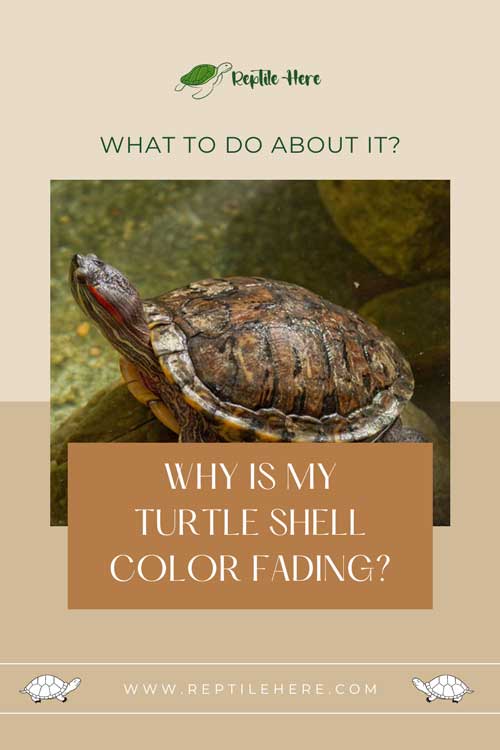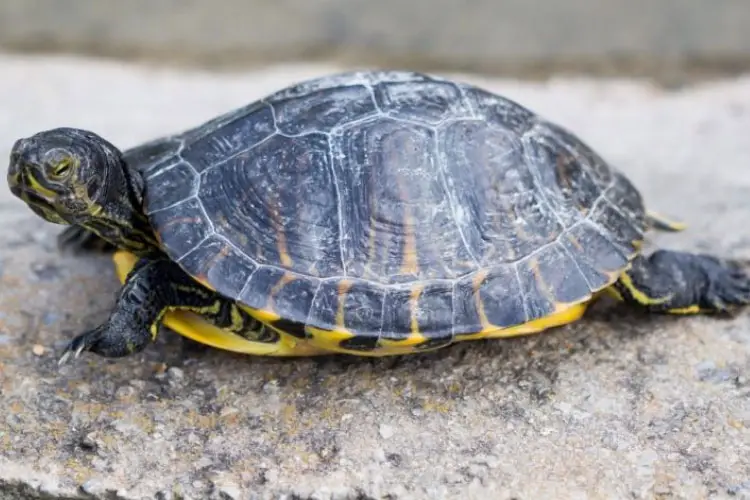Why Is My Turtle Shell Color Fading? What To Do About It?
Have you noticed a change of color in your turtle’s shell recently? If yes, you may grow curious as to whether this is a normal occurrence or if there’s something wrong with your dear turtle’s health.
Why is my turtle shell color fading? Your turtle shell color is fading probably due to a deficiency of key nutrients in their diet or lack of enough UV light. A shell rot or fungus infection may also cause the turtle shell discoloration.
In our comprehensive guide below, you’ll discover full details on why your turtle shell is fading, how to differentiate between healthy and unhealthy turtle shell color change, and how to fix this issue.
Why is my turtle shell color fading?
Contents
Turtle shell fading is something unnatural and you should be worried when your turtle has it. It could be a sign of an underlying health problem in your turtle pet.
The discoloration could appear in the form of the shell turning pale, washed out, or simply the shell losing its vibrancy.
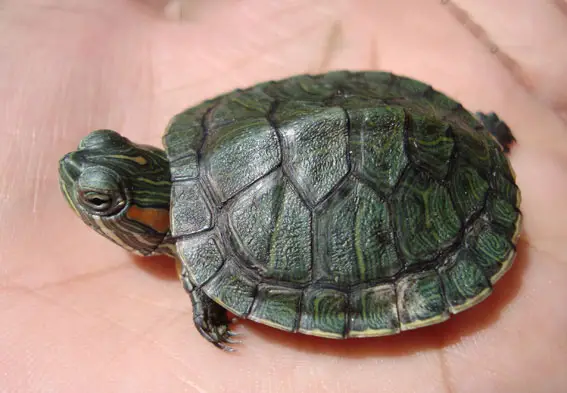
This problem usually has something to do with not taking good care of your turtle.
Listed below are the main causes for fading or discoloration in turtle shells:
Lack of UV light
One of the reasons behind turtle shell discoloration is the lack of UV light. Lack of exposure to UVB rays of light limits your turtle’s ability to properly absorb the calcium required for healthy growth, and their shells will start fading.
Make sure your turtle gets enough exposure to sunlight every day to maximize its calcium absorption. If you have your turtle housed indoors, be sure to place a UVB light bulb near their tank to ensure they have sufficient exposure to the light.
Some pet owners make the mistake of not replacing their UV bulbs with time. Unknown to them, however, these bulbs tend to lose their effectiveness over time, denying your turtle proper UV light exposure.
We advise you to change your UVB light from 6 months to 1 year.
Also, if possible, take your turtle outdoors to get a real dose of sunlight. This is because no matter how expensive a UV bulb you have invested in, it can never replace the actual UVB rays coming from the sun.
Poor nutrition
If your turtle has poor nutrition, without the essential minerals and vitamins, it may also be the reason behind its fading shell. This is because the turtle will be deprived of the key nutrients needed for healthy growth and maintenance of its shell.
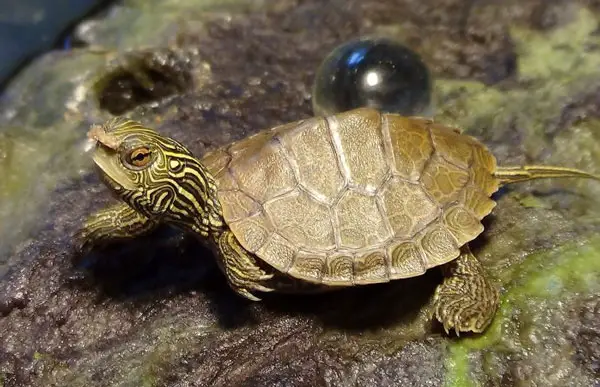
Luckily, this is something you can solve by improving your pet with a healthy and balanced diet. This should include not just the commercial turtle pellets but also fruits, veggies, and occasional worm feeding.
Low protein intake
Yes! If you don’t include proteins in your turtle’s diet, it may also make their shell turn pale or washed out. This is especially important for baby turtles which heavily rely on protein for proper growth.
Feeding your pet worms and insects mixed with pellets is an effective way to ensure they have enough proteins in their diet and keep off discoloration problems.
Hard water
Putting your turtle in an enclosure carrying hard water will also make its shell fade with time. But don’t get it wrong; hard water isn’t harmful to your shell’s health in any way.
However, the minerals like calcium and magnesium in the hard water will get deposited on the shell of your pet turtle scutes and make it look discolored or faded.
If you’re suspecting this could be the culprit affecting your little friend’s shell, you can try introducing a water filter in their tank to help bring down the mineral levels.
You can also make water changes using a water conditioner can also help reduce magnesium and calcium levels in the water—helping restore the turtle shell’s original color. When your turtle is basking, the water evaporates and the minerals are left on their shell, causing a discoloration.
As for the shell affected by hard water, you can try wiping it with a soft cloth to get rid of the minerals buildup. You can also try gently brushing your turtle shell with a soft toothbrush to get rid of these deposits.
NOTE: Some turtle owners mistake these mineral deposits for a fungal infection or shell rot. If the spot you’re skeptical about looks chalky and doesn’t feel soft to the touch or smelly, then you’re most likely dealing with hard water stains on your pet’s shell.
Should turtle shell colors change color?
Absolutely! Turtle shell colors do change color as these reptiles grow and age. Most newborn turtles usually feature bright green and yellow shells which then turn into darker colors as they become older.
Nearly any turtle species undergoes some degree of color change with time. Even the young ones of red-eared slider turtles usually have a bright green appearance. But as they transition into adult age, their shell will turn black, brown, or dark green.
If you want to be sure that a turtle shell color change has nothing to do with its health, observe it for any behavioral change. If it continues eating well and acting normally after undergoing color change, then there’s nothing wrong with it.
Natural and healthy color changes should also happen uniformly on every inch of the turtle’s shell.
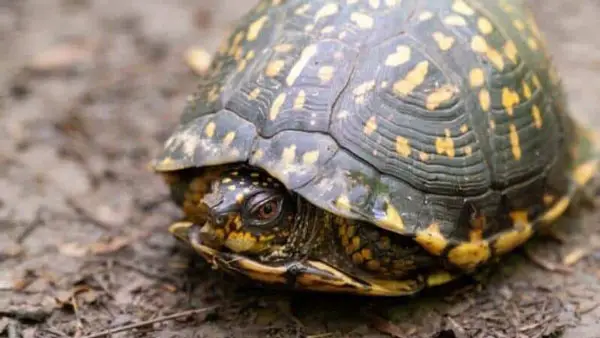
Here are a few cases that can bring about a natural color change in your turtle’s shell:
- Growth: The shell develops darker shades or becomes more evenly colored as your turtle grows. For instance, your baby turtle shell can change from a bright green or yellow color to black as it gets older. This is a natural occurrence that happens across nearly all turtle species
- Shedding: Turtles also shed their scutes as they grow. This is an important phase in their life and helps keep their shell healthy and free from fungal infections or shell rot. When the shedding occurs, the underlying layer looks bright and colorful. But as it gets exposed to the light, it starts dulling down and even takes the color of the surrounding.
- Environmental factors: Environmental factors may also be to blame for your turtle shell color changes. Turtles that live in an aquarium tend to feature a paler-looking shell compared to those that live under direct sunlight. This is because a natural environment provides the turtle with plenty of UV-B light which is necessary for helping produce vitamin D that facilitates healthy shell growth.
Note that bright colors in adult turtles are also attractive to the female turtles and help the males find a potential mating partner.
Why is my turtle’s shell turning white?
Your turtle’s shell turning white is mainly due to the hard water in its tank. As you already know, this type of water contains dissolved minerals. And these can get deposited on your turtle’s skin over time, creating a chalky substance (the hard water residue) with a whitish appearance.
As we said earlier, however, hard water isn’t dangerous for turtles and doesn’t affect their health in any way.
The good thing about the mineral despots is that you can easily get rid of them by wiping them out using a soft wet cloth or a soft toothbrush. If this method doesn’t work, you may consider consulting your vet.
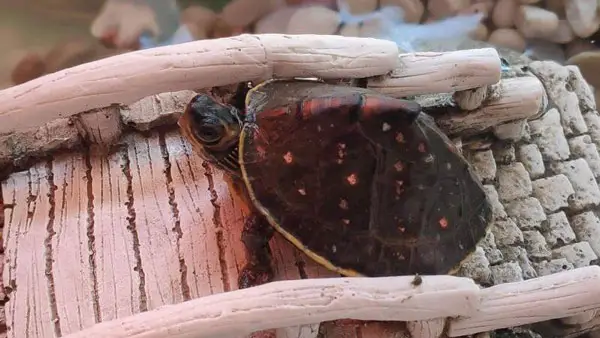
Your turtle’s shell could also turn white if they’re suffering from shell rot or fungal infection. This usually occurs as white spots on the shell and not uniformly. These health problems can turn fatal for your turtle friend, so you must act swiftly.
if you suspect the reason for your turtle’s shell turning pale or white is due to an infection or shell rot, we advise you to take him or her to the vet as soon as possible for professional diagnosis and treatment.
Why is my turtle shell turning gray?
Your turtle shell turning gray could be an indication of fungal infection. The gray spots or patches usually appear with the white spots discussed above and some pet owners will describe them as white-ish gray spots.
The shell fungus infection is usually caused by contaminated water or insufficient basking area (for proper UV light absorption).
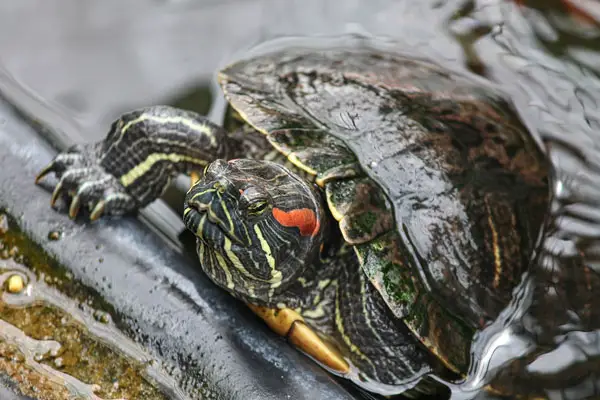
Aquatic turtles are highly vulnerable to these infections. But the good news is that it can be cured if treated properly and on time. But if left unattended, it can develop into shell rot which can be quite fatal!
Additional fungal infection symptoms in turtles include peeling of the skin or shell, blisters, soft shell, etc.
Needless to mention, you should take your pet turtle to the vet as soon as possible if you notice these signs of fungal infection.
Why is my turtle shell turning black?
If your turtle shell has turned black uniformly, on every inch of the cell, this could be normal growth and nothing serious. If the shell has black spots, however, it could be due to shell or fungal infection. Contact with UV light can also burn the shell and result in dark spots.
Shell rot is an infection or simply a rotting of the turtle shell and can cause black spots to appear on your turtle shell. This is a serious health problem and requires immediate veterinary attention.
If a fungal infection attacks your turtle’s shell, it can also make it have black spots. These will look like black patches or scaly skin growing in your turtle’s shell. This is also a serious problem and will need immediate vet attention.
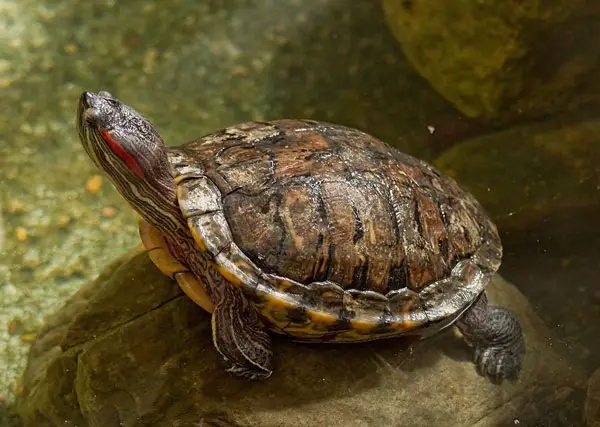
Placing your turtle in contact with UV light can burn its shell. This is highly possible given that some pet owners like placing their turtles directly on top of the UB bulb. Others place it too close to the basking bulb.
In either case, this can cause serious damage to your pet’s shell and should be avoided at all costs. Make sure you always maintain a safe distance between the basking bulb and your turtle friend’s basking platform.
When is turtle shell color change unhealthy?
You can tell when your turtle shell color change is healthy by looking for key signs of unhealthy shell discoloration such as patchy or uneven coloring, fading of stripes or markings, and the shell becoming lighter in color.
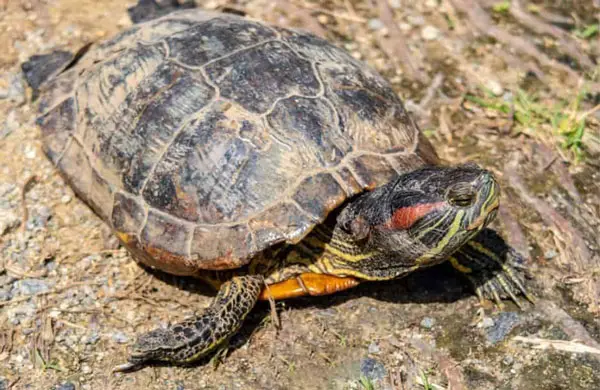
Generally, a healthy turtle shell should feature consistent, deep coloration across its entire shell. It should not have any spots or patches of dislocation, e.g. white, gray or black spots. A healthy turtle shell should also not be faded or bleached out.
Related questions (FAQs):
Your turtle’s shell losing color could be due to insufficient UV light, malnutrition, lack of enough proteins, or hard water or poor quality water. This usually happens due to neglecting your turtle and you can solve it by feeding them a balanced diet, giving them a daily dose of UV light rays, and keeping their environment clean.
The baby turtle shell fading could be due to lack of UV light and malnutrition. It could also be due to shell rot, a fungal infection, or simply putting them in hard water. Young turtles generally have deep dark coloring on their shells which get lighter as they grow, so you should take fading or discoloration of their shell seriously to ensure they don’t have an underlying health problem.
Final Word
Your turtle’s shell color dulling can be a sign of lack of nutrition and insufficient UV lighting. Other causes include hard water, poor water quality, shell rot, and fungal infection.
You can fix this by getting a UV light near its tank to enable it to absorb vitamins. You should also get supplements for your turtle to nip at. A healthy, balanced diet will also ensure your turtle gets all the key nutrients needed for a healthy shell.
If you’re not sure what the cause of shell fading is in your turtle, we advise you to visit your vet so they can diagnose the turtle and find out if they have any underlying issues such as shell rot or fungal infection. These are serious health issues for turtles and could turn fatal if not treated on time.
